Abstract
Gridshells are shells where the structural system is some kind of grid of linear members rather than a surface. With today’s focus on environmentally friendly solutions, gridshells have gained increased relevance as inherently material-efficient structures. This paper investigates the recent research on gridshells, who performs it and what their contributions are, and will thus provide an overview of the research field of gridshells. This study is performed as a systematic mapping. The articles were categorised by research type, motivation, contribution, gridshell type, material, and scientific field. The study shows that most articles are within structural engineering, whereas contributions from architecture were hard to find. The typical study was theoretical studies performing analyses on a specific load or structural behaviour. Some possible knowledge gaps were also identified, including review articles on loads and behaviour, research on bending active metal gridshells and development of gridshell nodes.
1. Introduction
With a world in need of environmentally friendly solutions, shell structures are relevant as a material-efficient way to construct buildings. Traditionally, shell structures demanded extensive manual labour for constructing the doubly curved shapes and were therefore popular as concrete or masonry shells in the period 1925–1975 [1], when materials were more expensive relative to labour than today. The recent development in digital design and digital manufacturing tools, enhanced by today’s focus on reducing material usage, can again favour shell structures. One particular type of shell, gridshells, are shells where the structural system is some kind of grid of linear members rather than a surface, often consisting of straight members connected at nodes. Gridshell construction can be favourable regarding prefabrication, transportation, and construction. The filigree construction of a gridshell also possesses aesthetic qualities regarding the curved global shape and the underlying construction. The gridshell members represent the bones of the structure, weaved in an exciting interplay of one or several materials, revealing the structural logic of the shell [2] (p. xvii), a quality often referred to as tectonics in architecture. The knots or joints connecting the bones of the gridshell could further enhance the material transition and structural sense.
Regarding the design of shells, it is said that the distinction between architect and engineer is almost artificial [3] and unclear who actually owns the design [2]. This study is motivated by an interest in the design of gridshells and investigates recent research in order to overview the status in the field, paying particular attention to the contributions from different professions in research. The study is conducted as a systematic mapping study. Some examples of reviews of gridshell research are focusing on the production and market [4] and the design and construction of kinematic gridshells [5,6], reticulated aluminium shells [7] and form and strength optimisation [8]. A recent review focuses on the triangle grid as a basis for construction [9]. Compared to the studies mentioned above, this study has a wider scope and maps all types of gridshells, gridshell parts and building materials. The study collects and categorises publications and discusses possible gaps in the research based on this mapping.
1.1. Focus and Terms
The following section presents the focus of the article and defines the main terms applied. See also Figure 1. A shell structure is a curved surface structure that derives its strength from its geometry, typically constructed from timber, metal, concrete or masonry. Shells are generally thin in the direction perpendicular to the surface, and work through a combination of membrane (mainly) and bending action [10] (p. 31). A Gridshell, lattice shell or reticulated shell is a general term for a shell constructed from some kind of grid of linear members rather than a surface. The terms are used inconsequently. Gridshell is most often used to describe those built with timber and bent during erection (bending active), while the term reticulated shell is more typically used for metal structures, often barrel vaults, spherical caps, or braced domes, for industrial purposes.
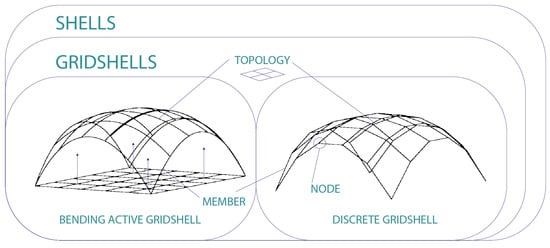
Figure 1.
Gridshell terminology.
Bending active gridshell, post formed, kinematic, elastic, active-bent or strained is a gridshell where the members are initially flat and bent into shape. The grid is typically quadrilateral, with one or several layers in each direction. After bending, the members are locked from further moving, typically by tightening connections and adding bracing as diagonal members or cables for providing in-plane shear stiffness. The most well-known example is probably the Mannheim Multihalle by Frei Otto [11]. A gridshell is often termed discrete gridshell or rigid gridshell when it consists of straight members connected at a node. As opposed to a bending active gridshell, the nodes typically cater for the geometrical changes between members, horizontal angle, tilt angle and torsion, depending on the global shape and topology. When discussing shape, global shape or just shape describe the overall geometry of the entire shell, representing both the building envelope as an architectural element and the structural system.
Topology, network, or grid pattern are terms for the logic and order of connectivity between the members of a gridshell. The most common topologies are quadrilateral and triangular; however, numerous topologies are possible. The topology contains information about the members and the nodes that connect them, and in a mesh representation, this corresponds to edges and vertices. A member is the strip of material that can be either continuous, like in a bending active gridshell, or shorter pieces between two nodes, like in a discrete gridshell. The node, joint, connection or knot is the physical object connecting two or more members. Whereas several members meet at the same point in a digital model, the node is designed to create the connection away from this point to make it physically possible. Nodes are typically constructed in metal regardless of member material because of the strong forces, especially bending moments, it needs to transfer.
1.2. Objectives
This study aims to provide an overview of recent research on gridshells. The following subquestions are defined:
- What is the amount of peer-reviewed journal papers on gridshells published yearly since 2011, how has this developed over time and what are the most common keywords?
- What are the scientific fields of the research, and who are the authors?
- What type of research is conducted?
- Which types of gridshells, which materials, and which parts of the gridshells are investigated?
2. Methods
This section describes the collection of data. A search query is defined and used to search several online databases. The results from the queries are then screened, as described further in Section 2.1, in order to filter out irrelevant literature. A classification of the literature and the topics covered in the literature is conducted, as described further in Section 2.2. This classification forms the basis of the systematic mapping. The study method is based on Petersen et al. [12]. The method is not so common in structural engineering and even less in architecture, but more used in the field of software engineering, which the method originates from [12]. Recent examples from other fields exist [13,14,15]. The systematic mapping supports the identification of knowledge gaps in the literature and does so in a scientific and traceable way.
The literature was gathered from Oria/NTNU, Science Direct, SCOPUS, Engineering Village and Web of Science. The search query was the same in all databases, following the setup from Table 1. The columns WHAT and WITH were joined by the Boolean operator AND, while the elements inside each column were joined by Boolean operator OR, forming the following query: “GRIDSHELL OR GRID SHELL OR RETICULATED SHELL OR LATTICE SHELL) AND (ARCHITECTURE OR BUILDING OR CONSTRUCTION OR STRUCTURE)”.

Table 1.
Keywords and limitations used in the search query.
The final search was carried out on 23 September 2021. The search was limited to the topic (title, abstract and keywords), which the databases allowed in various ways, and when possible, limited to journal articles, written in English. The exact search queries are found in Table 2. Table 2 also presents the number of results obtained from each database, a total of 2372 hits.

Table 2.
Number of articles obtained from each database using the search matrix and the exact query used. The query was conducted 23 September 2021.
2.1. Screening
After removing duplicates, a total of 1025 articles were considered for screening. Due to the large number of initial articles (1025), only articles published in peer-reviewed journals were included. This could ensure a better overall quality of the research but may leave out experimental/innovative early-phase research presented at conferences. In accordance with the aim to get an overview of the recent research in the field, only articles published after 2011 were included, leaving 467 articles. Titles and abstracts were read to apply the following inclusion criteria: The title and abstract should include one of the names of gridshell defined in Section 1.1 and describe research on gridshells. Furthermore, the topic of the article should concern gridshells at building scale and consider a shell structure as defined in Section 1.1. The screening was done parallel to the classification. Figure 2 illustrates the steps of the data collection and the screening process. A total of 327 articles passed screening and were used in the classification.

Figure 2.
Results from the article and data collection process.
Due to the screening criteria, typically, articles concerning facades, space frames and double layer shells, and hybrid structures, like suspen-dome and prestressed suspended shells, were excluded. Some project presentations were also excluded because the title or abstract did not mention gridshell, even though it is possible that the project was a gridshell, since it was collected with the query.
2.2. Classification
The classification of articles was done simultaneously with the screening. The scheme was, however, adjusted while reading, as illustrated in Figure 3. The classification scheme that was developed for this systematic map is divided into two main parts. Table 3 shows the general classification consisting of research type, research motivation and research contribution. Table 4 shows the second part, which consists of gridshell types, part of the gridshell, and material.
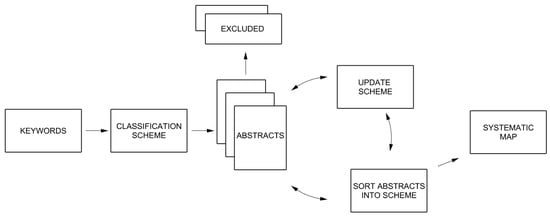
Figure 3.
Illustration of the systematic mapping process, developed from Petersen et al. [12].

Table 3.
Classification scheme regarding the scientific field, research type and research contribution for use in the systematic map.

Table 4.
Classification scheme regarding gridshell part, material, and type for use in the systematic map.
3. Gridshells in Recent Research
The objective of this study has been to get an overview of the field of gridshell research regarding the scholarly fields (who), the timeline of publications (when), the publication channels (where), and, maybe most important, grasp the content and focus of the research (what). The questions address these objectives, and the results are presented in the following subsections.
3.1. What Is the Amount of Peer-Reviewed Journal Papers on Gridshells Published Yearly since 2011, How Has This Developed over Time, and What Are the Most Common Keywords?
Following the query in the database search and the definitions used in the screening, this study has identified a total of 327 peer-reviewed journal papers concerning gridshells in the last ten years. As seen in Figure 4, the articles from the mapping increased from ten publications in 2011 to 58 in 2020.
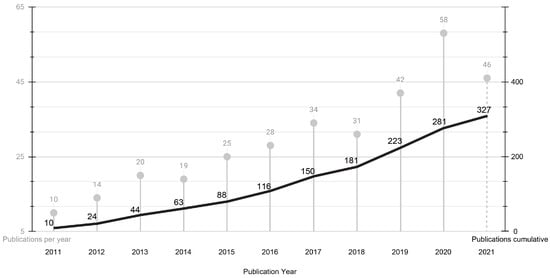
Figure 4.
Publications per year of the mapped articles. The search was conducted in September 2021 and is therefore not covering the total of 2021.
A brief overview of the content and focus of the gridshell research can be found in Figure 5. Here are the keywords from all articles mapped according to the concurrence, with a minimum of ten co-occurring keywords. This mapping resulted in a total of 54 keywords. The most occurring words can say something about research focus. The five most frequently occurring keywords were shells (structures) (133), structural engineering (44), buckling (42), finite element analysis (32) and structural design (32).

Figure 5.
Most frequent keywords from all publications mapped according to the concurrence. The colours represent clusters of keywords with higher co-occurrence. The map was created with VOSviewer [16].
3.2. What Are the Scientific Fields of the Research and Who Are the Authors?
Figure 6 shows the authors from the systematic map and a mapping of co-authorship. Out of 655 authors, most of them (561) appear in one or two articles. The authors with the most publications were Fan, F. (20), Baverel, O. (20), Liu, H. (18), Zhao, Z. (15) and Douthe, C. (14).
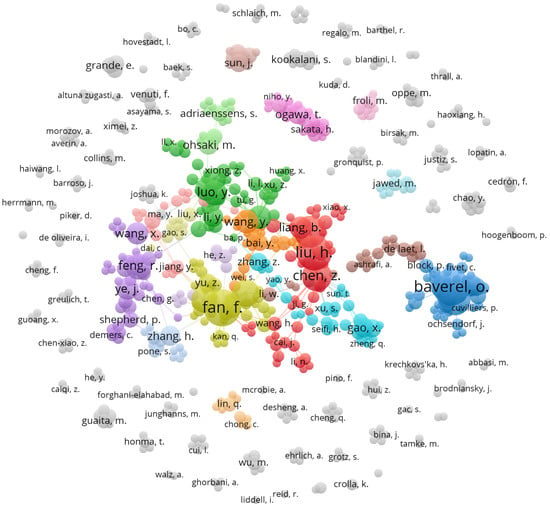
Figure 6.
Authors of all the publications mapped according to the co-authorship. The colours represent clusters of authors with higher co-authorship. The map was created with VOSviewer [16].
As seen in Figure 7, 278 articles were categorised in the field of structural engineering. The second-largest category was mechanical engineering (25). Few articles were categorised as architectural research (15), and even fewer as material science (8).
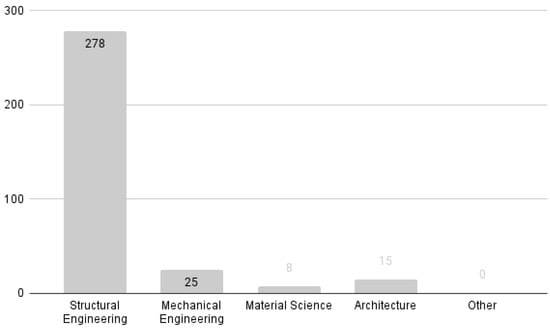
Figure 7.
Graph showing the scientific field of the mapped articles.
Table 5 presents the major publication channels for gridshell research. The top three publication channels were Engineering Structures (Elsevier, h5index 72), Thin-Walled Structures (Elsevier, h5-index 58) and Journal of the International Association for Shell and Spatial Structures (IASS, h5 index 11). As seen in Table 5, the list of publication channels shows many journals based in the structural engineering field, corresponding to the mapping of scholarly fields.

Table 5.
Publication channels for gridshell research with more than four articles and the number of articles.
3.3. What Type of Research Is Conducted?
The mapping shows that the research on gridshells is mainly structural engineers doing a theoretical study on either behaviour of gridshells or the effect of a particular load or load type. The following section presents findings in the individual facets research contribution, research motivation and research type. Figure 8 shows a combination of all three facets.
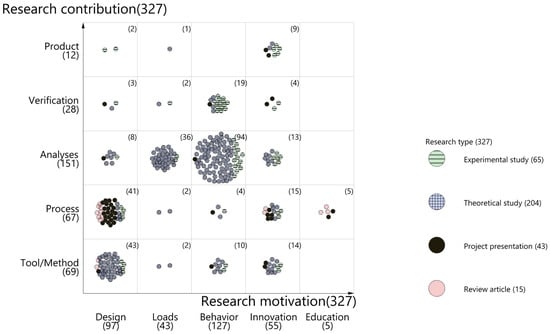
Figure 8.
Combination of the facets research motivation (x-axis), research contribution (y-axis) and research type (colour).
3.3.1. Research Contributions
The research contribution facet has been mapped in the five categories verification, tool/method, analyses, process and product, as described in Section 1.1. As seen in Figure 9, the most common contribution was analyses with 151 articles, followed by tool/method (69), processes (67), verification (28), and product (12).
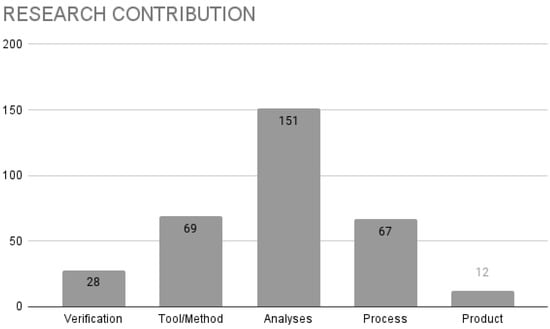
Figure 9.
Research contribution facet and the number of articles.
As seen in Figure 8, analyses’ contributions are typically motivated by behaviour (94), followed by loads (36). Furthermore, the analyses are mainly performed as theoretical studies. Examples from analyses are [17,18,19]. Tool/method contributions are typically motivated by design practice (43), followed by innovation (14). Furthermore, the tool/method contributions are also mainly performed as theoretical studies. Examples from tool/method are [20,21,22]. Process contributions are also typically motivated by design practice (41), followed by innovation (15). Furthermore, the process contributions are also mainly performed as project presentations. Examples from process are [23,24,25]. Verification contributions are also typically motivated by behaviour (19). Furthermore, the verification contributions are also mainly performed as experimental studies. Examples from verification are [26,27,28]. Product contributions are almost only motivated by innovation (9). Furthermore, the product contributions are mainly performed as experimental studies. Examples from products are [29,30,31]
3.3.2. Research Motivation
The research motivation facet has been mapped in the five categories, loads, behavior, education, design(practice) and innovation, as described in Section 1.1. As seen in Figure 10, the most common research motivation was behaviour with 127 articles, followed by design (97), innovation (55), loads (43) and “education” (5).
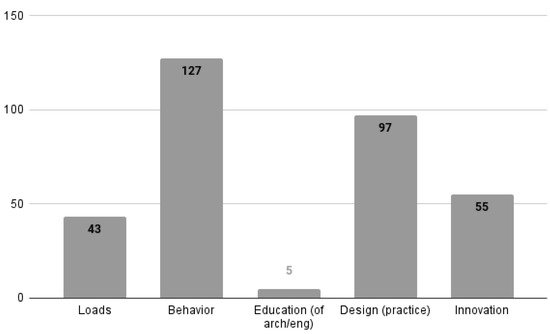
Figure 10.
Research motivation facet and the number of articles.
As seen in Figure 8, studies motivated by behaviour are, as mentioned above, typically contributing with analyses (94). Furthermore, the studies motivated by behaviour are typically performed as theoretical studies. Examples from behaviour are [18,26,32]. Studies motivated by design typically contribute with tool/method (43) or process (41). Furthermore, the studies motivated by design are typically performed as theoretical studies and, to a large extent, project presentations. Examples from design are [20,23,33]. Studies motivated by innovation are quite evenly contributing with either process (15), tool/method (14) or analyses (13). Furthermore, the studies motivated by innovation are typically performed as theoretical studies or experimental studies. Examples from innovation are [22,30,34].
Studies motivated by loads are typically contributing with analyses (36). Furthermore, the studies motivated by loads are typically performed as theoretical studies. Examples from loads are [17,29,35] Studies motivated by education are quite a few and only contribute with process (5). Furthermore, the studies motivated by education are performed as a review article or project presentation. Examples from education are [36,37,38]
3.3.3. Research Type
The research type facet was mapped in four categories, theoretical study, experimental study, project presentation, and review article, as described in Section 1.1. As seen in Figure 11, the most common research type found was theoretical studies with 204 articles. This was followed by experimental study (65), project presentation (43), and review article (15).
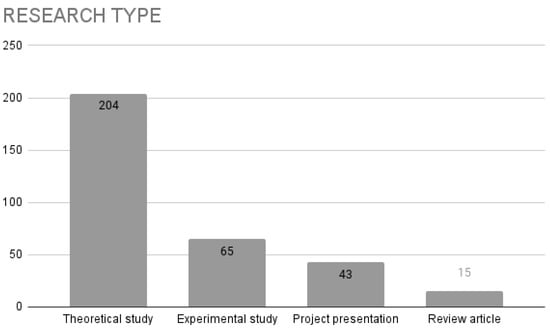
Figure 11.
Research type facet and the number of articles.
The theoretical studies, marked blue in Figure 8, consist mainly of analyses or tool/method regarding contributions. Furthermore, the theoretical studies are mainly motivated by behaviour. Examples of theoretical studies are [17,39,40]. The experimental studies, marked green in Figure 8, are divided relatively evenly amongst the contribution facets, with an overweight on the analyses. The experimental studies are also mainly motivated by behaviour. Examples of experimental studies are [19,26,30]. The project presentations, marked black in Figure 8, almost exclusively provide contributions regarding the process. Furthermore, the project presentations are mainly motivated by the design practice. Examples of project presentations are 2,8,9. The review articles, marked red in Figure 8, mainly provide contributions regarding the process and are mainly motivated by the design practice. Examples of review articles are [20,24,34].
3.4. Which Types of Gridshells, Which Materials, and Which Parts of the Gridshells Are Investigated?
The most typical study regarding the gridshell part is on global shape, without mentioning material or type, as seen in Figure 12. Moreover, most articles (176) did not mention which type of gridshell it investigated; however, in those studies where the type was decided, it is also typically evident which material and part were studied. The following section presents findings in the individual research facets—materials, parts and type.
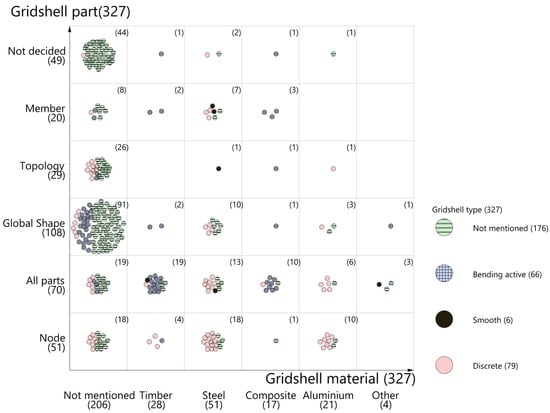
Figure 12.
Combination of the facets gridshell part (vertical axis), gridshell material (horizontal axis) and gridshell type (colour).
3.4.1. Gridshell Material
The gridshell material facet was mapped in the six categories, timber, steel, aluminium, composite, other and not mentioned, as described in Section 1.1. The material facet describes the member material. As seen in Figure 13, the material is typically not mentioned (206) in the studies. Steel (51) was, therefore, the most used material, followed by timber (28), aluminium (21), composite (17) and others (4). Regarding material, classification on the node-material was also done, but this resulted in even fewer articles where the material could be determined, and this facet was therefore excluded. When node material was determined, it was also almost always the same as the member material, with the exception of timber gridshells with metal nodes.
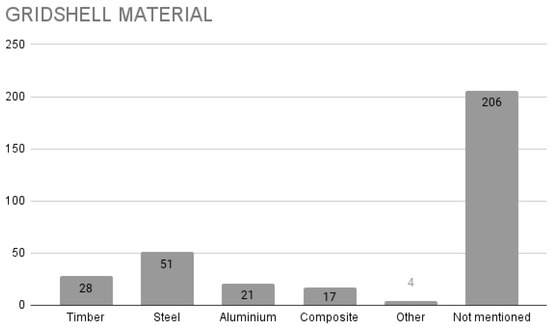
Figure 13.
Gridshell material facet and the number of articles.
As seen in Figure 12, steel gridshells are typically classified as discrete. Regarding gridshell parts, studies on steel gridshells focus on either the node (18), all parts (13) or the global shape (10). Examples of steel studies are [41,42,43,44]. Timber gridshells are typically classified as bending active. Regarding gridshell parts, studies on timber gridshells focus on either all parts (19) or nodes (4)”. Examples of timber studies are [23,36,45,46]. Aluminium gridshells are typically classified as discrete. Regarding gridshell parts, studies on aluminium gridshells focus typically on the node (10). Examples of aluminium studies are [30,47,48]. Composite gridshells are almost only classified as bending-active. Regarding gridshell parts, studies on composite gridshells typically focus on all parts (10). Examples of composite studies are [27,49,50]. Others are very few with no clear trends, except that they focus on all parts (4). Examples of other studies are [51,52,53]. Examples of studies where the material is not mentioned include [17,18,20]
3.4.2. Gridshell Part
The gridshell part facet was mapped in the five categories, global shape, topology, node, member and all parts, as described in Section 1.1. As seen in Figure 14, the part studied is typically the global shape with 108 studies. This is followed by studies on all parts (70), node (51), topology (29) and member (20). There were also 49 studies where the part could not be decided.
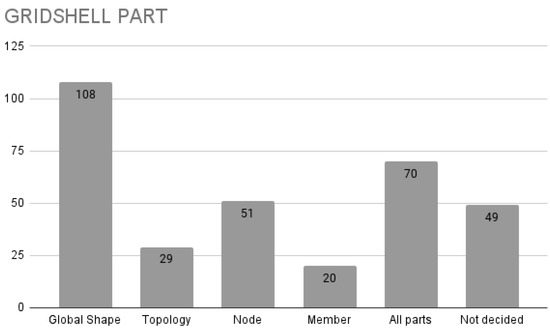
Figure 14.
Gridshell part facet and the number of articles.
As seen in Figure 12, studies on global shapes (108) were mostly bending active regarding gridshell type, although most have the not mentioned type. Regarding gridshell materials, studies on global shape do normally not specify the material, although some studies are classified as steel (10). Examples from global shape are [54,55,56]. Studies on the node (51) are mostly discrete regarding gridshell type. Regarding gridshell materials, studies on node are either on steel (12) or aluminium (10). Examples from node are [20,57,58]. Although most have not mentioned the type, studies on topology (29) are also mostly discrete regarding gridshell type. Regarding gridshell materials, studies on topology have typically not mentioned (26) materials either. Examples from topology are [59,60,61]. Studies on member (20) are also mostly bending active regarding gridshell type. Regarding gridshell materials, studies on the member are typically steel (7). Examples from member are [26,62,63].
3.4.3. Gridshell Type
The gridshell type facet was mapped in the four categories, bending active, smooth, discrete and not mentioned, as described in Section 1.1. As seen in Figure 15, the type studied is typically discrete with 79 studies. This is followed by studies on bending active gridshells (66) and smooth (6). There were, however, 176 studies where the type was not mentioned or not possible to determine.
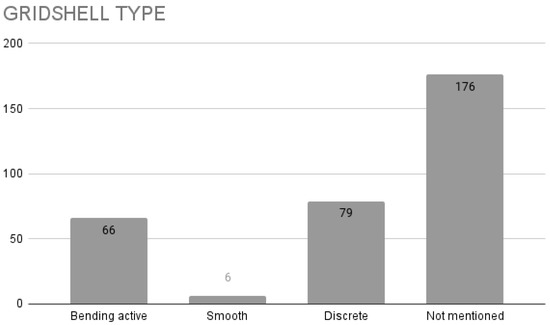
Figure 15.
Gridshell type facet and the number of articles.
The bending active gridshells, marked in blue in Figure 12, typically focus on all parts or the global shape regarding the gridshell part. Furthermore, the studies on bending active gridshells are mostly timber or composite regarding material. Examples from the bending active facet are [21,24,34]. The discrete gridshells, marked in red in Figure 12, typically focus on all parts or the node regarding the gridshell part. Furthermore, the studies on discrete gridshells are mostly steel regarding material. Examples from the discrete facet are [64,65,66]. The smooth gridshells, marked black in Figure 12, are relatively few and placed with no particular trends regarding part or material. Examples from the smooth facet are [23,67,68]. Examples of studies where the type was not mentioned are [54,69,70].
4. Discussion
4.1. Limitations to the Study
Some aspects should be considered when interpreting the results of this study. The study is not claiming to be a complete collection of all gridshell research, but it is a comprehensive collection of a rather large and general research topic. Some limitations were made during the collection of the data. The query formulation is a compromise between not excluding too many possible relevant articles and limiting the number of articles. More results could be retrieved by allowing more general search words, like “timber shell” or just “lattice dome”. In addition, the selection of databases was limited. Publications not indexed in these databases are not included, which could, for instance, exclude project presentations that could be found in architectural magazines. However, in this study, they would have been excluded in the screening because of the limitation to journal articles. The limitation to journal articles has also narrowed down the number of articles and possibly removed some less mature and more innovative research. The screening and classification were based on the title and abstract only. By including the full paper, some articles could be included whilst others were excluded from the screening, and the classification could have ended up with other categories. The fact that the full papers are not included also means that the knowledge gaps discussed in the following sections are, to a lesser extent, based on the content of the articles and instead come from the categories with few contributions. This study could therefore fail to find knowledge gaps in the categories that are well covered.
4.2. Publication Trend
According to the mapping, the research on gridshell has had a steady increase in publications from 10 in 2011 to 58 in 2020. The increase can indicate an increased interest in the research topic; however, it can also signify a changing/maturing naming convention. The research on gridshells prior to this study has been conducted since around 2017. The naming conventions used in the query are, therefore, most relevant for the most recent research. Significant research, however, has recently been published on gridshells in book format, including Timber Gridshells from 2016 [2], Bamboo Gridshells from 2015 [71], and Shell Structures for Architecture from 2014 [10]. These publications support the identification of an increased interest in and relevance of the topic.
4.3. Scientific Fields
The scientific field was almost exclusively found to be structural engineering (278 of 327). This was partly an expected result: Firstly, there are many aspects of gridshell design that are mainly a structural engineering topic. Analyses of gridshells, and especially the global shape, is typically performed by structural engineers. As Section 3.3 showed, there are also many approaches that the structural engineers can have to this research. Secondly, other fields, especially architecture, do not necessarily use the term gridshell (or similar) when describing what essentially is a gridshell roof. When describing a building from an architectural perspective, naming the correct structural type is not essential, and terms like glazed roof, reticulated structure, lattice dome or timber dome have also been used. Terms like these were considered in the initial query but were avoided as they also would generate irrelevant results.
4.4. Research Types, Contributions and Motivations
As mentioned before, most research is done by structural engineers and performed as analyses to examine behaviour or loads. Many of those studies present a traditional structural analysis that normally would have been part of a structural design report. The results from many of the analyses on behavoir or loads can be too specific because they are linked up to a shape and load combination that only apply in that particular study, and it can therefore be hard to use for others. It can be argued that these studies struggle to provide any contribution to the field.
A combination of facets with no or very few articles found in the systematic map can be used to identify knowledge gaps. Some of these are probably less relevant for novel gridshell research. There were for instance no theoretical studies on education and no review articles providing a product as its contribution. On the other hand, it was expected to find more contributions of products, like gridshell nodes which historically were developed as products by companies like Mero [72]. The mapping showed that little research contributed with a product (12). However, it is possible that such development mostly happens in the industry and, therefore, is not published as research. Lastly, the study did not find any review articles on loads or behaviour, which could serve as comprehensive guides for the design and understanding of gridshells for engineers and architects. Judging by the very high number of papers that present a theoretical study on loads or behaviour, it could be very beneficial if this information was reviewed, gathered, and compared. Examples of such reviews exist in the form of a book edited by Kato [73], which reports from the IASS working group 8 on buckling behaviour of metal gridshells and space frames, and a PhD dissertation by Malek [74], which studies the effect of topology and shape on the mechanical behaviour of spherical cap and corrugated vault gridshells. However, these works are not that recent (from 2012 and 2014) and different from the suggested review articles.
4.5. Gridshell Types, Parts and Materials
Regarding gridshell types, few examples of discrete gridshells in timber are found, as seen in Figure 12. However, there are recent examples known to the author. Explanations for this can be exemplified by the article from Harris et al. [75]. This conference paper presents the design and construction of a discrete timber gridshell. Although the terms gridshell, lattice or reticulated shell and reticulated structure have all been used (once) in that article, they are not in the abstract. Only the keyword timber shells is used to describe the structure type. Several articles like this might have been missed, either because of the naming or because they were published as conference papers. Similar to the previous section, it is possible to look at combinations of the facets with few or no articles to identify knowledge gaps. Figure 12 shows that examples of bending active steel or aluminium gridshells are not found in the study. If designed correctly (i.e., by finding a method to add shear stiffness to the cross-sections that need to be very thin to make bending possible), bending active metal gridshells could have exciting potential. One example not found in the mapping is Schling et al. [76], which constructs a bending active metal gridshell on an asymptotic surface. Only four studies focus on nodes for timber gridshells [77,78,79], corresponding with the few studies contributing with the product in the previous section. Research on nodes is therefore suggested as another knowledge gap. Only one study [61] looks into the nodes in bending active gridshells. Those nodes are typically solved as simple bolts or plates. They have remained almost unchanged since Mannheim Multihalle and could have a potential for new development, such as metal nodes, containing more details than the typical bolts and plates, or as wood–wood connections neglecting the need for any metal. Lastly, more studies on how to generate and optimise topology could be helpful for all gridshell types. Although the material selection should have an impact on the topology design, the studies on topology are typically not material-specific, and there are few limited to a material (3) [80,81,82]. Material specific design of the topology should give different results with, for instance, timber and steel because of their different characteristics. Discrete timber gridshells are for instance often designed with much longer members and thus coarser grids than steel gridshells. More research is therefore suggested on gridshell topologies, particularly linked to a material.
4.6. Implications from the Perspective of Architecture
As mentioned in the Introduction, it has been said that the distinction between engineer and architect can be almost artificial when it comes to the design of shell structures; however, as this study shows, the research mapped here is generally driven by structural engineers. Regarding recent examples of built gridshells that push the field forward, like the Swatch Omega Headquarters by Shigeru Ban [2] (p. 244), and Canary Wharf Crossrail Station by Foster and Partners [2] (p. 219), the architectural idea and how it is presented and perceived is what initiates the realisation of the gridshell. Architectural research on gridshells (as defined in Section 2.2), however, includes very few examples. The contributions from architecture found in this study are generally connected to the education of students and typically use bending active gridshells as a case. According to this study, it can be fair to say that the architecture field does not drive the traditional research on gridshells. However, by looking into, for instance, architectural magazines, one would find gridshell structures with high architectural quality, where the architectural concept has driven innovation in structural design. Recent examples of this are found in ArchDaily [83], Domus [84] and Structure [85]
If an architect aims to contribute to the field of gridshells, there could be two main directions. The first is to find the gaps in research, typically where the structural engineers are not contributing today. Some possible topics suitable for architects, like bending active metal gridshells and gridshell node design, are already mentioned in this study. The other direction is to start designing. If an architectural design involves a gridshell structure that can enchant the client, this can be a way to realise ambitious gridshells, building on the knowledge created by structural engineers and hopefully pushing the field further.
5. Conclusions
This systematic mapping study has investigated recent research on gridshells intending to get an overview of the field. Several databases were used to collect relevant research on gridshell, and a total of 327 papers were used in the mapping. The articles from the mapping increased from ten publications in 2011 to 58 in 2020, indicating a growing interest in gridshell research. The mapping has shown that 278 of the 327 articles on gridshells come from the field of structural engineering. In addition, 131 of the 327 mapped articles have been performed as a theoretical study that examined a specific load or behaviour. This corresponds to the keyword mapping, with buckling and finite element analysis among the most occurring keywords. Contributions from architecture were hard to find, indicating that it is not the architectural field that drives the traditional research on gridshells. However, as discussed, architects are instead contributing to the field through the design of gridshells.
The study has identified several knowledge gaps. The clearest is the lack of review articles on loads and behaviour, which could serve as comprehensive guides for the design and understanding of gridshells for engineers and architects. This is supported by the large number of independent theoretical studies on loads or behavior. Other possible gaps that have been identified are research on bending active metal gridshells, material-specific studies on topology, research on nodes in general and nodes for bending active gridshells in particular. Seeing these results from the perspective of architecture, all of the mentioned knowledge gaps are research topics where an architect could contribute. For an architect with interest in gridshells, the research future is open. In future work, it would be useful to go deeper into the articles from systematic mapping by extending it to a systematic review (see Petersen et al. [12]), and thus get insight into the content of the articles.
Author Contributions
Conceptualization and methodology, S.H.D., B.M. and A.R.; investigation, S.H.D.; writing—original draft preparation, S.H.D.; writing—review and editing, S.H.D. and B.M.; visualization, S.H.D.; supervision, B.M. and A.R. All authors have read and agreed to the published version of the manuscript.
Funding
The APC was funded by the Norwegian University of Science and Technology Publishing Fund.
Institutional Review Board Statement
Not applicable.
Informed Consent Statement
Not applicable.
Data Availability Statement
The complete mapping and bibliography used in this study are openly available in [Zenodo] at [https://www.doi.org/10.5281/zenodo.5754722] (accessed on 3 December 2021).
Acknowledgments
We thank the two anonymous reviewers whose comments/suggestions helped improve and clarify this manuscript.
Conflicts of Interest
The authors declare no conflict of interest.
References
- Chilton, J.; Chuang, C.C. Rooted in Nature: Aesthetics, Geometry and Structure in the Shells of Heinz Isler. Nexus Netw. J. 2017, 19, 763–785. [Google Scholar] [CrossRef] [Green Version]
- Chilton, J.; Tang, G. Timber Gridshells: Architecture, Structure and Craft; Routledge: London, UK, 2016. [Google Scholar]
- Williams, C. Decisions to Be Made in the Design of Gridshell Structures. 2017. Available online: https://www.youtube.com/watch?v=VPSw3dRE6xQ (accessed on 3 December 2021).
- Ghiyasinasab, M.; Lehoux, N.; Menard, S. Production Phases and Market for Timber Gridshell Structures: A State-of-the-Art Review. BioResources 2017, 12, 9538–9555. [Google Scholar] [CrossRef]
- Quinn, G.; Gengnagel, C. A Review of Elastic Grid Shells, Their Erection Methods and the Potential Use of Pneumatic Formwork. Mob. Rapidly Assem. Struct. IV 2014, 136, 129. [Google Scholar]
- Collins, M.; Cosgrove, T. A Review of the State of the Art of Timber Gridshell Design and Construction. In Proceedings of the Ivil Engineering Research in Ireland CERI 2016, Civil Engineering Research Association of Ireland CERAI, West Coast, Ireland, 29–30 August 2016. [Google Scholar]
- Yang, L.; Wei, S.; Zhang, Q. Aluminum Reticulated Spatial Structures: State of the Art and Key Issues. J. Build. Struct. 2013, 34, 1–19. [Google Scholar]
- Yamamoto, K.; Ogawa, T.; Fujimoto, M.; Lazaro, C.; Takeuchi, T.; Xue, S.D.; Chen, P.S.; Kato, S. State-of-the-Art for Optimization of Forms and Strength for Reticulated Shells. In IASS Annual Symposium; IASS-APCS: London, UK, 2012. [Google Scholar]
- Meza, E.G. The Triangle Grid, the Evolution of Layered Shells since the Beginning of the 19th Century. Curved Layer. Struct. 2021, 8, 337–353. [Google Scholar] [CrossRef]
- Adriaenssens, S.; Block, P.; Veenendaal, D.; Williams, C. Shell Structures for Architecture: Form Finding and Optimization; Routledge: London, UK, 2014. [Google Scholar]
- Happold, E.; Lidell, W. Timber Lattice Roof for the Mannheim Bundesgartenschau; The Structural Engineer: Great Britain, UK, 1975; p. 37. [Google Scholar]
- Petersen, K.; Feldt, R.; Mujtaba, S.; Mattsson, M. Systematic Mapping Studies in Software Engineering. In Proceedings of the 12th International Conference on Evaluation and Assessment in Software Engineering (EASE) 12, Karlskrona, Sweden, 15–16 June 2008; pp. 1–10. [Google Scholar]
- Labonnote, N.; Høyland, K. Smart Home Technologies That Support Independent Living: Challenges and Opportunities for the Building Industry–a Systematic Mapping Study. Intell. Build. Int. 2017, 9, 40–63. [Google Scholar] [CrossRef]
- Akoka, J.; Comyn-Wattiau, I.; Laoufi, N. Research on Big Data–A Systematic Mapping Study. Comput. Stand. Interfaces 2017, 54, 105–115. [Google Scholar] [CrossRef]
- Kastrati, Z.; Dalipi, F.; Imran, A.S.; Pireva Nuci, K.; Wani, M.A. Sentiment Analysis of Students’ Feedback with NLP and Deep Learning: A Systematic Mapping Study. Appl. Sci. 2021, 11, 3986. [Google Scholar] [CrossRef]
- Van Eck, N.J.; Waltman, L. VOSviewer Manual. Leiden Univeristeit Leiden 2013, 1, 1–53. [Google Scholar]
- Zhong, Y.; Yun, X.; Bing, Z.; Xujun, C. Dynamic Analysis of Reticulated Shell Subjected to Earthquake Excitation. Appl. Mech. Mater. 2011, 90, 1461–1466. [Google Scholar] [CrossRef]
- Wang, X. Element Stiffness Matrix of Members of Reticulated Shell with End Springs. Appl. Mech. Mater. 2011, 94, 289–292. [Google Scholar] [CrossRef]
- Ye, J.; Liu, W.; Pan, R. Research on Failure Scenarios of Domes Based on Form Vulnerability. Sci. China Technol. Sci. 2011, 54, 2834–2853. [Google Scholar] [CrossRef]
- Fan, F.; Ma, H.; Cao, Z.; Shen, S. A New Classification System for the Joints Used in Lattice Shells. Thin-Walled Struct. 2011, 49, 1544–1553. [Google Scholar] [CrossRef]
- Kuijvenhoven, M.; Hoogenboom, P.C.J. Particle-Spring Method for Form Finding Grid Shell Structures Consisting of Flexible Members. J. Int. Assoc. Shell Spat. Struct. 2012, 53, 31–38. [Google Scholar]
- Okita, Y.; Honma, T. Structural Morphogenesis for Free-Form Grid Shell Using Genetic Algorithms with Manipulation of Decent Solution Search. J. Int. Assoc. Shell Spat. Struct. 2012, 53, 177–184. [Google Scholar]
- Lewis, B. Centre Pompidou - Metz: Engineering the Roof. Struct. Eng. 2011, 89, 20–25. [Google Scholar]
- Harris, R. Design of Timber Gridded Shell Structures. Proc. Inst. Civ. Eng. Struct. Build. 2011, 164, 105–116. [Google Scholar] [CrossRef]
- Schober, H.; Justiz, S.; Tamai, H. Speed and Grace. Civ. Eng. Mag. Arch. 2011, 81, 54–59. [Google Scholar] [CrossRef]
- Sun, T.; Ma, K.; Chen, Z.; Yin, Y.; Liu, J. Damage Assessment, Repair and Field Test of Steel Lattice Shell after Fire. Trans. Tianjin Univ. 2012, 18, 121–127. [Google Scholar] [CrossRef]
- Jensen, T.J.; Baverel, O.; Douthe, C. Morphological and Mechanical Investigation of Interconnected Elastic Gridshells. Int. J. Space Struct. 2013, 28, 175–186. [Google Scholar] [CrossRef] [Green Version]
- Hernández, E.L.; Baverel, O.; Gengnagel, C. On the Design and Construction of Elastic Gridshells with Irregular Meshes. Int. J. Space Struct. 2013, 28, 161–174. [Google Scholar] [CrossRef]
- Feng, R.Q.; Ye, J.H.; Yao, B. Evaluation of the Buckling Load of an Elliptic Paraboloid Cable-Braced Grid Shell Using the Continuum Analogy. J. Eng.-Mech.-ASCE 2012, 138, 1468–1478. [Google Scholar] [CrossRef]
- Shi, G.; Ban, H.Y.; Bai, Y.; Wang, Y.Q.; Luo, C.; Shi, Y.J. A Novel Cast Aluminum Joint for Reticulated Shell Structures: Experimental Study and Modeling. Adv. Struct. Eng. 2013, 16, 1047–1059. [Google Scholar] [CrossRef]
- Horner, M.; Rhode-Barbarigos, L.; Adriaenssens, S. Site-Specific Louvered Shells for Shading Harmful Ultraviolet Radiation. Build. Environ. 2014, 78, 14–22. [Google Scholar] [CrossRef]
- Gao, Y.; Zhang, Z.; Shi, Y.; Wang, Y.; Li, G. Stability Analyses for Single Arch of Arch-Reticulated Shell Hybrid Steel Structure of Conservatories at Gardens by the Bay in Singapore. Adv. Mater. Res. 2011, 243, 832–837. [Google Scholar] [CrossRef]
- Sobek, W.; Blandini, L.; Krtscha, A. The special structures for the Mansueto Library in Chicago. From design to construction. STAHLBAU 2011, 3–6. [Google Scholar] [CrossRef]
- Baverel, O.; Caron, J.F.; Tayeb, F.; Peloux, L.D. Gridshells in Composite Materials: Construction of a 300 m 2 Forum for the Solidays’ Festival in Paris. Struct. Eng. Int. J. Int. Assoc. Bridge Struct. Eng. (IABSE) 2012, 22, 408–414. [Google Scholar] [CrossRef]
- Ogawa, T.; Kumagai, T.; Minowa, K.; Kato, S. Buckling Load of Saddle-Shaped HP Reticulated Shells. J. Int. Assoc. Shell Spat. Struct. 2012, 53, 57–67. [Google Scholar]
- Tang, G. Timber Gridshells: Beyond the Drawing Board. Proc. Inst. Civ. Eng. Constr. Mater. 2013, 166, 390–402. [Google Scholar] [CrossRef] [Green Version]
- Gac, S. Physical Analog Models in Architectural Design. Int. J. Space Struct. 2016, 31, 16–24. [Google Scholar] [CrossRef]
- Crolla, K. Bending Bamboo Rules: Beyond Century-Old Typologies. J. Archit. Educ. 2018, 72, 135–145. [Google Scholar] [CrossRef]
- Malek, S.; Wierzbicki, T.; Ochsendorf, J. Buckling of Spherical Cap Gridshells: A Numerical and Analytical Study Revisiting the Concept of the Equivalent Continuum. Eng. Struct. 2014, 75, 288–298. [Google Scholar] [CrossRef]
- Ma, J.L.; Wu, C.Q.; Zhi, X.D.; Fan, F. Prediction of Confined Blast Loading in Single-Layer Lattice Shells. Adv. Struct. Eng. 2014, 17, 1029–1043. [Google Scholar] [CrossRef]
- Weiming, Y.; Zhuo, W.; Haoxiang, H. Research on Mode Localization of Reticulated Shell Structures. Earthq. Eng. Eng. Vib. 2011, 10, 75–84. [Google Scholar] [CrossRef]
- Yu, Z.; Zhi, X.; Fan, F.; Lu, C. Failure Mechanism of Single-Layer Saddle-Curve Reticulated Shells with Material Damage Accumulation Considered under Severe Earthquake. Int. J. Steel Struct. 2012, 12, 125–137. [Google Scholar] [CrossRef]
- Zhi, X.D.; Fan, F.; Shen, S.Z. Failure Mechanism of Single-Layer Cylindrical Reticulated Shells under Earthquake Motion. Int. J. Struct. Stab. Dyn. 2012, 12, 233–249. [Google Scholar] [CrossRef]
- Altuna Zugasti, A.M.; Lopez-Arancibia, A.; Puente, I. Influence of Geometrical and Structural Parameters on the Behaviour of Squared Plan-Form Single-Layer Structures. J. Constr. Steel Res. 2012, 72, 219–226. [Google Scholar] [CrossRef]
- Liddell, I. Frei Otto and the Development of Gridshells. Case Stud. Struct. Eng. 2015, 4, 39–49. [Google Scholar] [CrossRef] [Green Version]
- Lara-Bocanegra, A.J.; Majano-Majano, A.; Arriaga, F.; Guaita, M. Eucalyptus Globulus Finger Jointed Solid Timber and Glued Laminated Timber with Superior Mechanical Properties: Characterisation and Application in Strained Gridshells. Constr. Build. Mater. 2020, 265, 120355. [Google Scholar] [CrossRef]
- Liu, H.; Chen, Z.; Xu, S.; Bu, Y. Structural Behavior of Aluminum Reticulated Shell Structures Considering Semi-Rigid and Skin Effect. Struct. Eng. Mech. 2015, 54, 121–133. [Google Scholar] [CrossRef]
- Jiang, Y.; Ma, H.; Richard Liew, J.Y.; Fan, F. Testing of Aluminum Alloyed Bolted Joints for Connecting Aluminum Rectangular Hollow Sections in Reticulated Shells. Eng. Struct. 2020, 218, 110848. [Google Scholar] [CrossRef]
- Nicholas, P.; Tamke, M. Computational Strategies for the Architectural Design of Bending Active Structures. Int. J. Space Struct. 2013, 28, 215–228. [Google Scholar] [CrossRef]
- Gengnagel, C.; Hernández, E.L.; Bäumer, R. Natural-Fibre-Reinforced Plastics in Actively Bent Structures. Proc. Inst. Civ. Eng. Constr. Mater. 2013, 166, 365–377. [Google Scholar] [CrossRef] [Green Version]
- Tang, G.; Pedreschi, R. Gridshell as Formwork: Proof of Concept for a New Technique for Constructing Thin Concrete Shells Supported by Gridshell as Formwork. J. Archit. Eng. 2020, 26, 04020036. [Google Scholar] [CrossRef]
- Pronk, A.; Li, Q.P.; Mergny, E. Structural modelling, construction and test of the first 3D-printed gridshell in ice composite. J. Int. Assoc. Shell Spat. Struct. 2020, 61, 177–186. [Google Scholar] [CrossRef]
- Coar, L.; Hare, J.; De Laet, L.; Cha, Y.J.; Suh, G.; Piper, J.; Jiang, V. A Study of Digital and Physical Workflows Used for the Creation of Fabric-Formed Ice Shells with Bending Active Frames. Int. J. Space Struct. 2021, 36, 13–25. [Google Scholar] [CrossRef]
- Jun, Z.; Yi, S.; Guoang, X. Design Recommendation For Large Depth-to-Span Ratio and Opening Of Single-Layer Sperical Lattice Shells. Appl. Mech. Mater. 2013, 351–352, 109–113. [Google Scholar] [CrossRef]
- Zhai, X.M.; Wang, Y.H. Modelling and Dynamic Response of Steel Reticulated Shell under Blast Loading. Shock Vib. 2013, 20, 19–28. [Google Scholar] [CrossRef]
- Feng, R.Q.; Ge, J.M. Shape Optimization Method of Free-Form Cable-Braced Grid Shells Based on the Translational Surfaces Technique. Int. J. Steel Struct. 2013, 13, 435–444. [Google Scholar] [CrossRef]
- de Oliveira, I.M.; Pauletti, R.M.D.; Meneghetti, L.C. Connection System for Gridshell Structures Using Parametric Modeling and Digital Fabrication. Autom. Constr. 2020, 109, 102996. [Google Scholar] [CrossRef]
- Zhao, C.; Ma, J.; Du, S.; Gu, Y.; Zhou, Y. Mechanical Properties of a Novel Joint of a Single-Layer Aluminum-Alloy Combined Lattice-Shell Structure. Mater. Tehnol. 2019, 53, 811–819. [Google Scholar] [CrossRef]
- Goodarzi, M.; Mohades, A.; Forghani-Elahabad, M. Improving the Gridshells’ Regularity by Using Evolutionary Techniques. Mathematics 2021, 9, 440. [Google Scholar] [CrossRef]
- Yang, Y.; Ma, H. Optimal Topology Design of Replaceable Bar Dampers of a Reticulated Shell Based on Sensitivity Analysis. Earthq. Eng. Eng. Vib. 2014, 13, 113–124. [Google Scholar] [CrossRef]
- Bouhaya, L.; Baverel, O.; Caron, J.F. Optimization of Gridshell Bar Orientation Using a Simplified Genetic Approach. Struct. Multidiscip. Optim. 2014, 50, 839–848. [Google Scholar] [CrossRef] [Green Version]
- Tayeb, F.; Caron, J.F.; Baverel, O.; Du Pelowel, L. Stability and Robustness of a 300 m(2) Composite Gridshell Structure. Constr. Build. Mater. 2013, 49, 926–938. [Google Scholar] [CrossRef] [Green Version]
- Renzhang, Y.; Zhihua, C.; Xiaodun, W.; Xiao, X.; Yuan, Y. Calculation Theory and Experimental Study of the K6 Single-Layer Reticulated Shell. Int. J. Steel Struct. 2014, 14, 195–212. [Google Scholar] [CrossRef]
- Cai, J.; Xu, Y.; Feng, J.; Zhang, J. Design and Analysis of a Glass Roof Structure. Struct. Des. Tall Spec. Build. 2013, 22, 677–686. [Google Scholar] [CrossRef]
- Seifi, H.; Javan, A.R.; Xu, S.Q.; Zhao, Y.; Xie, Y.M. Design Optimization and Additive Manufacturing of Nodes in Gridshell Structures. Eng. Struct. 2018, 160, 161–170. [Google Scholar] [CrossRef]
- Göppert, K.; Stockhusen, K.; Grotz, S. Arena Da Amazônia, Manaus. Der Stahlbau 2014, 83, 383–389. [Google Scholar] [CrossRef]
- Sanchez-Alvarez, J. Rationalisation of the Geometry for Production of the 80-m Glazed Sphere for the Expo 2017 in Astana. Int. J. Space Struct. 2017, 32, 176–183. [Google Scholar] [CrossRef]
- He, S.; Wang, H.; Bordas, S.P.A.; Yu, P. A Developed Damage Constitutive Model for Circular Steel Tubes of Reticulated Shells. Int. J. Struct. Stab. Dyn. 2020, 20. [Google Scholar] [CrossRef]
- Li, N.; Feng, J.; Lu, J.Y. Meshing and Integrated Optimisation for Free-Form Reticulated Shells. IES J. Part A: Civ. Struct. Eng. 2013, 6, 158–164. [Google Scholar] [CrossRef]
- Xue, S.D.; Wang, N.; Ll, X.Y. Study on Shell Element Modeling of Single-Layer Cylindrical Reticulated Shell. J. Int. Assoc. Shell Spat. Struct. 2013, 54, 57–66. [Google Scholar]
- Rockwood, D. Bamboo Gridshells; Routledge: London, UK, 2015. [Google Scholar]
- Stephan, S.; Sánchez-Alvarez, J.; Knebel, K. Reticulated structures on free-form surfaces. Stahlbau 2004, 73, 562–572. [Google Scholar] [CrossRef]
- Kato, S.; Abedi, K.; Chen, P.; Fan, F.; Fujimoto, M.; Gantes, C.; Ishikawa, K.; Kawaguchi, K.; Kim, S.D.; Lázaro, C.; et al. Guide to Buckling Load Evaluation of Metal Reticulated Roof Structures (Report of Activities WG 8) v20171224; International Association for Shell and Spatial Structures: Madrid, Spain, 2014. [Google Scholar]
- Malek, S.R. The Effect of Geometry and Topology on the Mechanics of Grid Shells. Ph.D. Thesis, Massachusetts Institute of Technology, Cambridge, MA, USA, 2012. [Google Scholar]
- Harris, R.; Gusinde, B.; Roynon, J. Design and Construction of the Pods Sports Academy, Scunthorpe, England. In Proceedings of the World Conference of Timber Engineering, Auckland, New Zealand, 15–19 July 2012; p. 9. [Google Scholar]
- Schling, E.; Hitrec, D.; Schikore, J.; Barthel, R. Design and Construction of the Asymptotic Pavilion. In Proceedings of the Structural Membranes, Munich, Germany, 9–11 October 2017. [Google Scholar]
- Harada, H.; Nakajima, S.; Yamazaki, Y.; Matsui, R.; Hayashi, K.; Sakata, H.; Takeuchi, T. Rotational stiffness and bending strength of steel connections in timber lattice shell. J. Struct. Constr. Eng. 2018, 83, 577–587. [Google Scholar] [CrossRef] [Green Version]
- Nakajima, S.; Terazawa, Y.; Takeuchi, T.; Ogawa, T.; Yamazaki, Y.; Sakata, H. Elastic buckling strength of timber lattice shell with steel connections considering rotational stiffness. J. Struct. Constr. Eng. 2019, 84, 1081–1091. [Google Scholar] [CrossRef]
- Regalo, M.L.; Gabriele, S.; Salerno, G.; Varano, V. Numerical Methods for Post-Formed Timber Gridshells: Simulation of the Forming Process and Assessment of R-Funicularity. Eng. Struct. 2020, 206. [Google Scholar] [CrossRef]
- He, Y.J.; Zhou, X.H.; Liu, D. Research on Stability of Single-Layer Inverted Catenary Cylindrical Reticulated Shells. Thin-Walled Struct. 2014, 82, 233–244. [Google Scholar] [CrossRef]
- Brütting, J.; Senatore, G.; Fivet, C. Design and Fabrication of a Reusable Kit of Parts for Diverse Structures. Autom. Constr. 2021, 125, 103614. [Google Scholar] [CrossRef]
- Schling, E.; Barthel, R. Suchov’s Bent Networks: The Impact of Network Curvature on Suchov’s Gridshell Designs. STRUCTURES 2021, 29, 1496–1506. [Google Scholar] [CrossRef]
- Pintos, P. Taiyuan Botanical Garden/Delugan Meissl Associated Architects. 2021. Available online: https://www.archdaily.com/962872/taiyuan-botanical-garden-delugan-meissl-associated-architects (accessed on 1 December 2021).
- Crescenzi, V. Swatch Headquarters by Shigeru Ban Opened in Biel. 2019. Available online: https://www.domusweb.it/en/architecture/gallery/2019/10/14/swatch-opens-its-shigeru-ban-designed-headquarters-in-biel.html (accessed on 1 December 2021).
- Burkhard, F. A Jungle in the Greenhouse: Jewel at Changi Airport in Singapore. 2019. Available online: https://www.detail-online.com/article/a-jungle-in-the-greenhouse-jewel-at-changi-airport-in-singapore-34633/ (accessed on 1 December 2021).
Publisher’s Note: MDPI stays neutral with regard to jurisdictional claims in published maps and institutional affiliations. |
© 2021 by the authors. Licensee MDPI, Basel, Switzerland. This article is an open access article distributed under the terms and conditions of the Creative Commons Attribution (CC BY) license (https://creativecommons.org/licenses/by/4.0/).